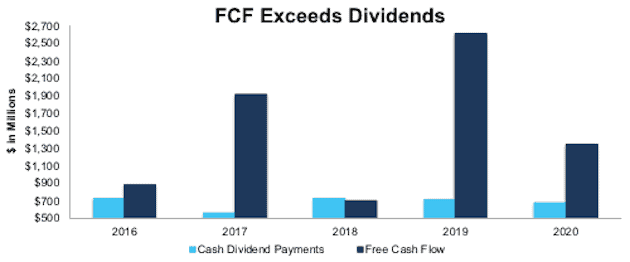Nine new stocks make our Safest Dividend Yields Model Portfolio this month, which was made available to members on September 23, 2020.
Recap from August’s Picks
On a price return basis, our Safest Dividend Yields Model Portfolio (-2.5%) outperformed the S&P 500 (-3.3%) by 0.8% from August 20, 2020 through September 21, 2020. On a total return basis, the Model Portfolio (-2.1%) outperformed the S&P 500 (-2.9%) by 0.8% over the same time. The best performing large cap stock was up 11% and the best performing small cap stock was up 6%. Overall, 12 out of the 20 Safest Dividend Yield stocks outperformed their respective benchmarks (S&P 500 and Russell 2000) from August 20, 2020 through September 21, 2020.
Only our research utilizes the superior data and earnings adjustments featured by the HBS & MIT Sloan paper,"Core Earnings: New Data and Evidence.” This Model Portfolio leverages our Robo-Analyst technology[1], which scales our forensic accounting expertise (featured in Barron’s) across thousands of stocks.[2]
This Model Portfolio only includes stocks that earn an Attractive or Very Attractive rating, have positive free cash flow and economic earnings, and offer a dividend yield greater than 3%. Companies with strong free cash flow provide higher quality and safer dividend yields because we know they have the cash to support the dividend. We think this portfolio provides a uniquely well-screened group of stocks that can help clients outperform.
Featured Stock for September: Seagate Technology, PLC (STX: $49/share)
Seagate Technology (STX), is the featured stock in September’s Safest Dividend Yields Model Portfolio.
We made Seagate a Long Idea in September 2010 and closed out the position in August 2015. The stock outperformed the S&P 500 (up 361% vs. S&P up 86%) over that time. Once again, STX offers attractive risk/reward.
Seagate has grown net operating profit after-tax (NOPAT) by 23% compounded annually since fiscal-year-ended (FYE) 2016 and by 7% compounded annually over the past nine years. Seagate’s NOPAT margin increased from 5% in FYE 2016 to 13% in FYE 2020, while the firm’s invested capital turns improved from 1.5 to 1.6 over the same time. Rising margins and invested capital turns drive Seagate’s return on invested capital (ROIC) from 8% in FYE 2016 to 21% in FYE 2020. Most importantly, Seagate’s economic earnings, the true cash flows of the business, grew from $186 million in FYE 2016 to $1 billion in FYE 2020, or 53% compounded annually.
Figure 1: Seagate’s Economic Earnings Since FYE 2016

Sources: New Constructs, LLC and company filings
Cash Flow Supports Dividend Payments
Seagate has paid a dividend in each of the past 10 years. The firm increased its dividend payments from $2.43/share in FYE 2016 to $2.58/share in FYE 2020, or 2% compounded annually. The current quarterly dividend, when annualized provides a 5.2% dividend yield.
Seagate’s dividend payment is supported by the firm’s strong free cash flow (FCF). Seagate generated $7.5 billion (58% of current market cap) in FCF while paying $3.4 billion in dividends from FYE 2016 to FYE 2020, per Figure 2.
Figure 2: Seagate’s FCF vs. Dividends Since FYE 2016

Sources: New Constructs, LLC and company filings
Companies with strong FCF provide higher quality dividend yields because we know the firm has the cash to support its dividend. On the other hand, dividends from companies with low or negative FCF cannot be trusted as much because the company may not be able to sustain paying dividends.
STX Is Undervalued
At its current price of $49/share, STX has a price-to-economic book value (PEBV) ratio of 0.6. This ratio means the market expects Seagate’s NOPAT to permanently decline by 40%. This expectation seems overly pessimistic given that Seagate has grown NOPAT by 5% compounded annually over the past 15 years.
Even if Seagate’s margin falls to 11% (all-time average vs. 13% in FYE 2020) and the firm grows revenue by 2% compounded annually, which results in NOPAT falling by <1% compounded annually over the next decade, the stock is worth $84/share today – a 71% upside. See the math behind this reverse DCF scenario.
Critical Details Found in Financial Filings by Our Robo-Analyst Technology
As investors focus more on fundamental research, research automation technology is needed to analyze all the critical financial details in financial filings as shown in the Harvard Business School and MIT Sloan paper,"Core Earnings: New Data and Evidence”.
Below are specifics on the adjustments we make based on Robo-Analyst findings in Seagate’s FYE 2020 10-K:
Income Statement: we made $406 million of adjustments with a net effect of removing $366 million in non-operating expenses (3% of revenue). See all adjustments made to Seagate’s income statement here.
Balance Sheet: we made $5.2 billion of adjustments to calculate invested capital with a net increase of $236 million. The most notable adjustment was $2.6 billion (42% of reported net assets) in asset write-downs. See all adjustments to Seagate’s balance sheet here.
Valuation: we made $6 billion of adjustments with a net effect of decreasing shareholder value by $3.3 billion. Apart from total debt, one of the most notable adjustments to shareholder value was $1.3 billion in excess cash. This adjustment represents 10% of Seagate’s market value. See all adjustments to Seagate’s valuation here.
This article originally published on October 1, 2020.
Disclosure: David Trainer, Kyle Guske II, and Matt Shuler receive no compensation to write about any specific stock, style, or theme.
Follow us on Twitter, Facebook, LinkedIn, and StockTwits for real-time alerts on all our research.
[1] Harvard Business School features the powerful impact of our research automation technology in the case New Constructs: Disrupting Fundamental Analysis with Robo-Analysts.
[2] Compare our analytics on a mega cap company to Bloomberg and Capital IQ’s (SPGI) analytics in the detailed appendix of this paper.
